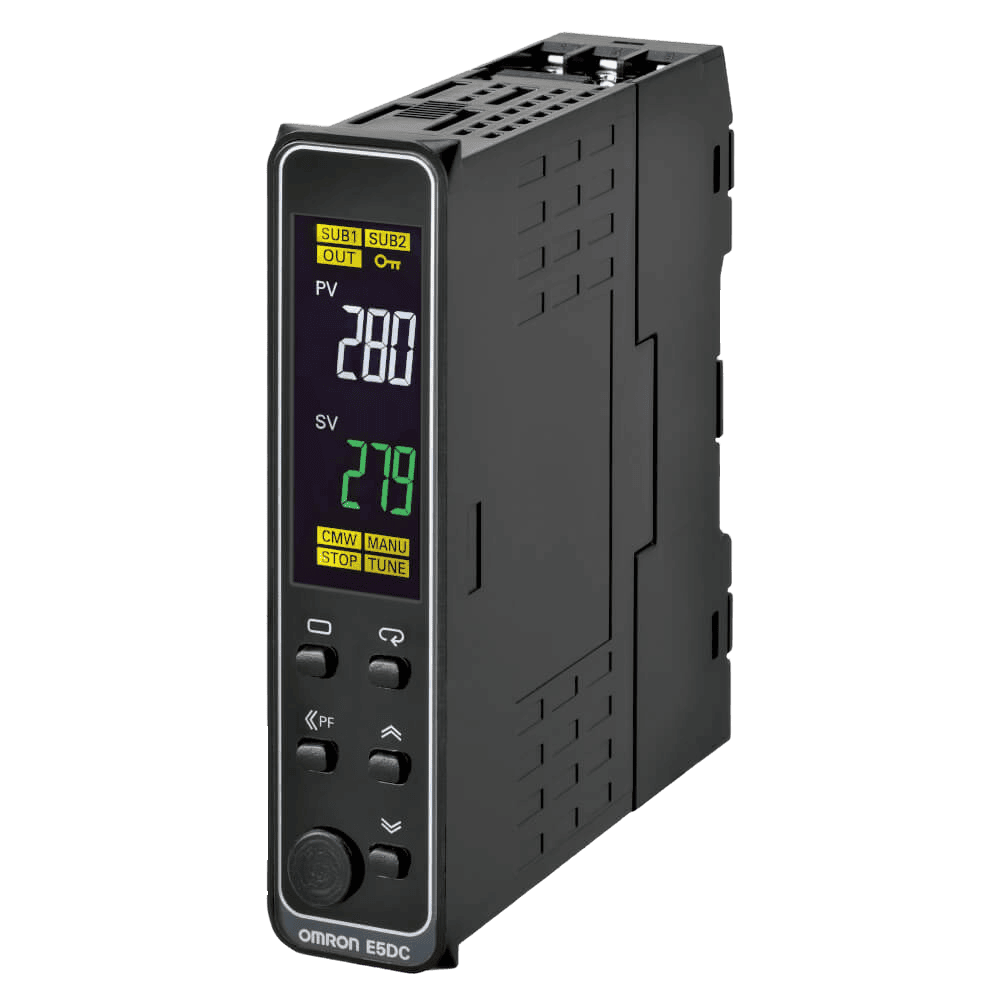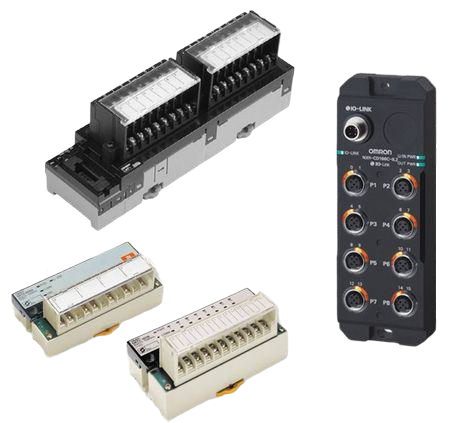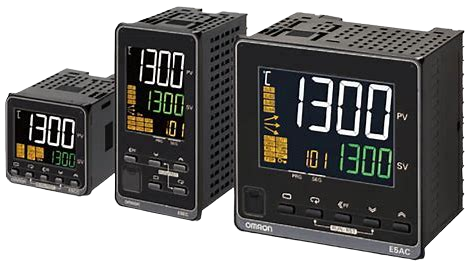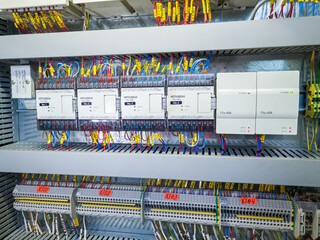Omron controllers
21.06.2024

Today, automation is the key to achieving the highest efficiency, accuracy, and reliability. Controllers are at the center of automated systems - sophisticated devices that control and direct complex processes. Among the best solutions are Omron controllers, which stand out for their innovative technology and exceptional performance.
Omron has built a solid reputation for delivering high-quality automation solutions that cater to a wide range of industries, including manufacturing, automotive, pharmaceuticals, and more. Their controllers are designed to meet the stringent demands of modern industrial applications, offering unmatched flexibility, scalability, and integration capabilities.
This article will guide you through the world of Omron controllers, highlighting their key features, the advantages they offer, and practical tips on choosing, installing, and maintaining these powerful devices. Whether you're an industry veteran or just beginning your journey into automation, understanding the potential of Omron controllers can unlock new levels of productivity and operational excellence.
What Are Omron Controllers?
Omron controllers are sophisticated, high-performance devices designed to manage and automate various industrial processes. They serve as the central hub in an automated system, executing programmed instructions to control machinery, monitor processes, and ensure everything operates seamlessly. As a vital component in industrial automation, Omron controllers enhance efficiency, accuracy, and safety across a multitude of industries.
Definition and Purpose
Omron controllers are electronic devices used in industrial automation to manage and control equipment and processes. These controllers interpret signals from sensors, execute pre-programmed instructions, and send commands to actuators, thereby orchestrating complex tasks with precision. Their primary purpose is to automate repetitive, hazardous, or intricate processes, reducing the need for manual intervention and minimizing the potential for human error.
The core function of Omron controllers is to gather data from various inputs, process this data according to user-defined logic, and then control outputs to drive machinery and other industrial equipment. This automation capability leads to increased productivity, consistent product quality, and enhanced operational safety.
Key Features Controllers
Omron controllers are renowned for their advanced features, which set them apart in the field of industrial automation. Some of the key features include:
- High-Speed Processing
Omron controllers are equipped with powerful processors that enable high-speed data processing. This capability ensures real-time control and quick response times, which are crucial for maintaining the efficiency and accuracy of industrial processes.
- Extensive Connectivity Options
These controllers offer a wide range of connectivity options, including Ethernet, USB, and serial communications. This extensive connectivity allows seamless integration with other devices and systems, such as Human-Machine Interfaces (HMI), Supervisory Control and Data Acquisition (SCADA) systems, and Internet of Things (IoT) platforms.
- Robust Design
Designed for durability, Omron controllers are built to withstand harsh industrial environments. They are resistant to dust, moisture, and temperature variations, ensuring reliable performance in demanding conditions.
- User-Friendly Interfaces
Omron controllers feature intuitive interfaces that make programming and operation straightforward. User-friendly software tools and graphical programming environments allow engineers and technicians to develop, test, and deploy control logic with ease.
- Flexibility and Scalability
These controllers are highly flexible and scalable, making them suitable for a wide range of applications. Whether it's a small-scale automation project or a large, complex industrial system, Omron controllers can be configured to meet specific requirements.
- Advanced Diagnostics and Maintenance Tools
Omron controllers come with built-in diagnostics and maintenance tools that help identify issues quickly and efficiently. These tools provide detailed error logs, status indicators, and remote monitoring capabilities, which facilitate proactive maintenance and reduce downtime.
- Security Features
To protect against cyber threats and unauthorized access, Omron controllers incorporate robust security features. These include user authentication, data encryption, and secure communication protocols, ensuring the integrity and confidentiality of industrial control systems.
- Energy Efficiency
Omron controllers are designed with energy efficiency in mind. They optimize power consumption during operation, contributing to overall energy savings and reducing operational costs.
Types of Omron controllers
Omron offers a wide range of controllers for automating various tasks in industry. Their controllers fall into four main categories:
1. Programmable logic controllers (PLC)
Omron PLCs are universal controllers used to control various industrial processes. They offer a wide range of features including:
- Logic programming: PLCs can be programmed using IEC 61131 languages such as Ladder Diagram, Function Block Diagram and Structured Text.
- I/O: PLCs have various I/O modules to connect to sensors, actuators and other devices.
- Communication: PLCs support various communication protocols such as Ethernet, Modbus and RS-232.
- Expansion: The PLC can be expanded with additional modules such as analog I/O modules, communication modules and positioning modules.
2. Traffic controllers
Omron motion controllers are used to control the motion of servos and other actuators. They offer a wide range of features including:
- Positioning: Motion controllers can precisely position actuators with high precision.
- Speed: Controllers can adjust the speed of actuators with high precision.
- Synchronization: Motion controllers can synchronize the motion of multiple actuators.
- Profiling: Motion controllers can control the movement of actuators according to the given profiles.
3. Temperature controllers
Omron temperature controllers are used for temperature control in various industrial processes. They offer a wide range of features including:
- Temperature Control: Temperature controllers can precisely control the temperature with high precision.
- Alarm: Controllers can signal when the temperature exceeds the permissible limits.
- Data recording: Temperature controllers can record temperature data for later analysis.
4. Security controllers
Omron safety controllers are used to ensure safety in industrial processes. They offer a wide range of features including:
- Emergency stop: Safety controllers can stop dangerous machines and processes.
- Protecting people: Safety monitors can protect people from injury.
- Safety monitoring: Safety controllers can monitor safety devices such as light barriers and emergency switches.
Advantages of using Omron controllers
1. Reliability
- High-quality components: Omron controllers are made of high-quality components that have been thoroughly tested to ensure their reliability and durability.
- Wide operating temperature range: Controller omron can operate in a wide temperature range, making them resistant to extreme environmental conditions.
- Vibration and shock proof: Omron controllers are vibration and shock proof, making them ideal for use in harsh environments.
- Data duplication: Omron controllers can duplicate data on external media, which guarantees the preservation of important information.
2. Flexibility
- Wide range of models: Omron offers a wide range of controller models to suit different needs and budgets.
- Modular design: Many Omron controller have a modular design that allows for easy expansion of functionality.
- Programmability: Omron controllers are programmable using IEC 61131 languages, giving users the flexibility to customize their operation.
- Support of various communication protocols: Omron controller support various communication protocols, which allows them to be easily integrated with other systems.

3. Possibilities of integration
- Support for industrial networks: Controller omron support various industrial networks such as Ethernet, Modbus and Profinet.
- OPC UA support: Omron controllers support OPC UA, allowing them to easily integrate with SCADA and MES systems.
- Integration with cloud services: Omron controllers can be integrated with cloud services, allowing users to remotely monitor and control their operation.
4. Convenient interfaces
- Easy-to-use interfaces: Omron controllers have easy-to-use interfaces, making them easy to program and configure.
- Touch Screen Support: Many Omron controllers have touch screens, making them even more convenient to use.
- Graphical User Interfaces: Omron controllers offer graphical user interfaces that make them easy to understand and use.
How Omron Controllers Improve Efficiency
Omron controllers offer a wide range of features that can help improve efficiency in a variety of industries. Here are some of the key ways Omron controllers can help you achieve this:
Automation of Repetitive Tasks
- Eliminating Human Error: Repetitive tasks are prone to human error, which can lead to inconsistencies and defects in production. Omron controllers automate these tasks, ensuring precision and uniformity. By programming specific instructions into the controllers, tasks are executed flawlessly, reducing the likelihood of errors.
- Increasing Throughput: Automation of repetitive tasks with Omron controller significantly boosts throughput. Machines can operate continuously without breaks, unlike human workers who require rest. This continuous operation results in higher production rates and improved overall productivity.
- Freeing Up Human Resources: By taking over monotonous tasks, Omron controllers free up human workers to focus on more complex and value-added activities. This not only enhances worker satisfaction but also allows for better utilization of human resources in areas where they can contribute more effectively.
Enhanced Precision
- High-Resolution Control: Omron controllers are equipped with high-resolution control capabilities, enabling precise manipulation of machinery and processes. This precision is crucial in industries where even minor deviations can lead to significant issues, such as in pharmaceuticals, electronics, and aerospace manufacturing.
- Consistent Quality: Precision control ensures that every product is manufactured to the exact specifications, resulting in consistent quality. This consistency is vital for maintaining brand reputation and meeting regulatory standards. Omron controllers ensure that each cycle of production adheres to the predefined parameters, minimizing variations.
- Advanced Sensing and Feedback: Omron controllers integrate advanced sensing and feedback mechanisms that continuously monitor and adjust operations in real-time. This dynamic adjustment capability ensures optimal performance and maintains precision throughout the production process, even in the face of varying conditions.
Reduced Downtime
- Predictive Maintenance: One of the key features of Omron controllers is their ability to support predictive maintenance. By continuously monitoring the condition of equipment and processes, these controllers can predict potential failures before they occur. This allows for timely maintenance, preventing unexpected breakdowns and reducing downtime.
- Rapid Troubleshooting: Omron controllers come with built-in diagnostic tools that facilitate rapid troubleshooting. When an issue arises, these tools provide detailed insights into the problem, enabling quick identification and resolution. This minimizes the time taken to address issues, ensuring that production resumes promptly.
- Robust and Durable Design: Designed to withstand harsh industrial environments, Omron controllers are highly durable and reliable. Their robust construction reduces the frequency of failures and the need for repairs, contributing to lower downtime and sustained operational efficiency.
Energy Savings
- Optimized Power Consumption: Omron controllers are engineered to optimize power consumption across automated processes. By precisely controlling the operation of machinery and adjusting parameters in real-time, they ensure that only the necessary amount of energy is used. This leads to significant energy savings, which is both economically and environmentally beneficial.
- Efficient Motor Control: A substantial portion of industrial energy consumption is attributed to motor operations. Omron controllers provide efficient motor control, adjusting speeds and loads to match the specific requirements of the task. This not only reduces energy consumption but also extends the lifespan of the motors.
- Reduced Waste: Precision control and automation reduce material waste, which indirectly contributes to energy savings. By ensuring that processes are carried out accurately and consistently, Omron controllers minimize the scrap and rework that often result from errors and inconsistencies.
How to choose the right Omron controller for your needs
1. Define your needs
The first step to choosing the right Omron controller is to have a clear understanding of your needs. You will need to consider factors such as:
- Control Type: What type of control do you need? Do you need a PLC, motion controller, temperature controller, safety controller or other type of controller?
- Functionality: What features do you need in a controller? Do you need features like logic programming, regulation, data acquisition, communication, and more?
- I/O: How many I/O points do you need? What types of signals do you need to input and output?
- Performance: What kind of performance do you need from a controller? Do you need a controller with high processing speed, large memory or other features?
- Environment: In what conditions will the controller work? Do you need a controller that is resistant to extreme temperatures, vibrations, shocks or other environmental factors?
- Budget: How much are you willing to spend on a controller?
2. Explore the available options: Omron offers a wide range of controllers, so it's important to research the options available to find the one that best suits your needs. You can find information about Omron controllers on the Omron website, in catalogs or from Omron distributors.
3. Compare features and specifications: Once you've narrowed down your choices to a few controllers, it's important to compare their features and specs. Consider factors such as control type, functionality, I/O, performance, environment, and price.
4. Get a consultation: If you are not sure which Omron controller to choose, you can ask an Eltra distributor for advice. We will help you assess your needs and recommend the best controller for your application.
5. Make sure you have the necessary tools and software: You will need the necessary tools and software to program and configure the Omron controller. Omron offers a wide range of tools and software to help you get started.
6. Choose a reliable supplier: It is important to choose a reliable supplier of Omron controllers - this is Eltra. The Eltra supplier has 12 years of experience with Omron controllers and can provide you with the support you need.
7. Read the operating instructions: It is important to read the operating instructions carefully before using the Omron controller. It will help you to install, configure and operate the controller correctly.

Installation and Maintenance Tips
Ensuring the optimal performance and longevity of Omron controllers requires careful installation and regular maintenance. Following best practices for installation, establishing routine maintenance schedules, and knowing how to troubleshoot common issues can significantly enhance the efficiency and reliability of your automation systems.
Best Practices for Installation
- Planning and Preparation: Before you start the installation process, thorough planning and preparation are essential. Assess the installation site to ensure it meets the necessary environmental conditions, such as temperature, humidity, and cleanliness. Gather all required tools, equipment, and documentation, including wiring diagrams and user manuals.
- Proper Mounting: Mount the controller securely in a well-ventilated area to prevent overheating. Use the appropriate mounting hardware and follow Omron’s guidelines for spacing and orientation. Avoid placing the controller near sources of vibration, electromagnetic interference, or direct sunlight.
- Electrical Connections: Ensure that all electrical connections are made accurately and securely. Use high-quality cables and connectors to minimize the risk of signal interference or connection failures. Label all wires clearly to simplify future maintenance and troubleshooting. Double-check that the power supply meets the controller’s specifications to avoid damage from incorrect voltage or current.
- Grounding and Shielding: Proper grounding and shielding are crucial for protecting the controller from electrical noise and surges. Connect the controller’s ground terminal to a solid earth ground and use shielded cables for signal lines. Ensure that the shields are connected to ground at one end only to prevent ground loops.
- Software Configuration: After the hardware installation, configure the controller’s software settings according to your application requirements. Use Omron’s programming tools, such as CX-One or Sysmac Studio, to set up the control logic, communication parameters, and other configurations. Test the software thoroughly to ensure it performs as expected before going live.
Regular Maintenance Routines
- Visual Inspections: Conduct regular visual inspections of the controller and its surroundings. Check for signs of wear, damage, or contamination on the controller, wiring, and connectors. Look for loose connections, corrosion, or any unusual indications that might suggest a problem.
- Cleaning: Keep the controller and its environment clean and free from dust, dirt, and debris. Use a soft brush or compressed air to remove dust from the controller’s surface and ventilation openings. Avoid using liquids or solvents that could damage the electronics.
- Firmware and Software Updates: Regularly update the controller’s firmware and software to the latest versions provided by Omron. These updates often include important bug fixes, security enhancements, and performance improvements. Follow Omron’s instructions for safely applying updates to avoid disrupting your automation processes.
- Functional Testing: Perform functional tests periodically to verify that the controller is operating correctly. Test all inputs, outputs, and communication interfaces to ensure they respond as expected. Document the results and any anomalies to track the controller’s performance over time.
Troubleshooting Common Issues
Communication Failures
If the controller is experiencing communication failures, check the following:
- Ensure that all cables are securely connected and free from damage.
- Verify that the communication settings in the controller and the connected devices match.
- Inspect the network for any sources of interference or excessive traffic.
- Restart the controller and the connected devices to reset the communication link.
Overheating
Overheating can lead to reduced performance or damage to the controller. To address this issue:
- Ensure that the controller is mounted in a well-ventilated area.
- Check that the ventilation openings are not blocked by dust or debris.
- Confirm that the ambient temperature is within the controller’s specified operating range.
- If necessary, install additional cooling solutions, such as fans or heat sinks.
Unexpected Shutdowns
If the controller shuts down unexpectedly, investigate the following potential causes:
- Check for power supply issues, such as voltage fluctuations or interruptions.
- Inspect the controller for signs of overheating or electrical faults.
- Review the event logs or diagnostic tools to identify any error codes or warnings.
- Reset the controller and observe if the issue reoccurs, then consult Omron’s support if needed.
Inconsistent Performance
Inconsistent performance can be due to various factors. To troubleshoot this:
- Verify that the controller’s firmware and software are up-to-date.
- Check for loose or intermittent connections in the wiring.
- Ensure that the input signals are stable and within the expected range.
- Perform a detailed review of the control logic to identify any programming errors or inefficiencies.
Conclusion
Omron controllers stand out as a crucial component in the realm of industrial automation, offering unparalleled reliability, flexibility, and efficiency. From automating repetitive tasks to enhancing precision and reducing downtime, these controllers are designed to meet the demanding needs of various industrial applications. Proper installation and maintenance further ensure their optimal performance and longevity, contributing to the smooth and uninterrupted operation of production processes.
When it comes to sourcing Omron controllers, Eltra Trade is a trusted and reliable distributor. Our knowledgeable managers are always ready to answer your questions and assist you in selecting the controller that best fits your specific requirements. By choosing the right controller and ensuring timely maintenance, you can achieve reliable and efficient production, minimizing downtime and maximizing productivity.
For all your Omron controller needs, rely on Eltra Trade to provide high-quality products and exceptional customer support, helping you maintain a seamless and efficient automation system.